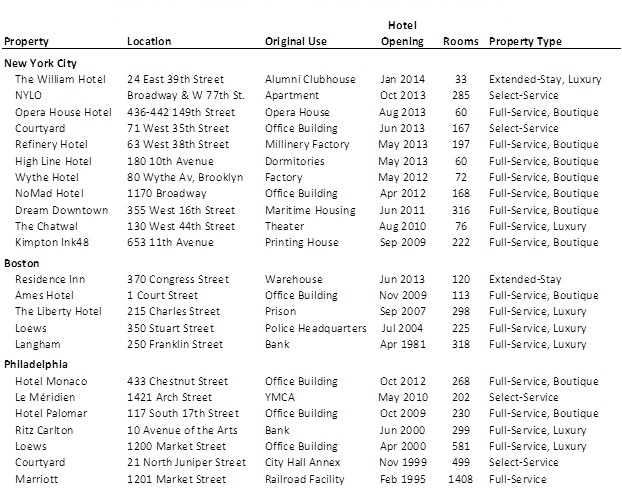
Due to the diminishing availability and rising cost of land in top urban lodging markets such as New York City, hoteliers are thinking more strategically about where to invest and how to make the most of existing resources, often turning to creating hotel venues in structures that have outlived their original purpose. This approach, known as adaptive reuse, typically entails the redevelopment of a historic building, with the primary focus being to preserve authentic characteristics of the original structure while creating a functional interior that will satisfy the expectations of current travelers. Due to inherent building features that cannot always be properly tailored to meet brand standards, branding such a property may add extra expense to the project and encumber potential developers. As a result, this approach is particularly well suited for independent properties, which tend to succeed in urban markets like New York and other major city centers.
Some Companies Embrace Approach
Environmental benefits inherent in the adaptive reuse approach include the recycling of materials, reuse of structural elements and the reduction in generated landfill waste. Even if a newly constructed hotel is extremely energy efficient, it will generally exhaust more energy than renovating an existing building due to the environmental impact generated from all the newly sourced materials used in the construction. Existing buildings that are rapidly approaching disuse or demolition are mines of raw materials and often require a complete overhaul of the existing structure, thereby allowing environmental performance to become a leading priority. Several companies, including Kimpton Hotels and NYLO Hotels have fully embraced adaptive reuse developments as an opportunity to revitalize urban city center locations while utilizing energy-saving innovations. A variety of buildings in New York City that have been adapted for hotel use are presented in the table below.

Balancing environmental performance and historic preservation while ensuring a high level of quality and comfort can be challenging, requiring extensive due diligence and important deliberations regarding the building structure and engineering. In general, structures that have outlived their original purpose suffer from a lack of investment and require fire, life safety, mechanical, electrical and plumbing systems upgrades, as well as a full seismic upgrade to accommodate the new facilities and patrons. Further considerations include the effects of potential windows installations and through-wall or roof-mounted HVAC equipment on the aesthetic, historical and architectural values of the historic building. Federal, State and Municipal legislation limit the scope of structural alterations that can be made to designated historic buildings, therefore, there is often very little that can be done with the external façade, as legislations aim to retain the visual integrity of the exterior walls, the regular pattern of the window bays, as well as the ornamental elements. HVAC is a particularly important issue that can have a direct impact on the architectural features of the building, as well as on customer satisfaction and the environmental performance of the building. Upgrading the HVAC system in existing structures is an important initiative as it can often be the principal issue with inefficiencies. Despite the challenges associated with structure and engineering, this development approach offers a variety of benefits with regards to financing and environmental designation.
The redevelopment of historic properties is often made possible by complicated financing packages that may include a variety of financial incentives including historic tax credits (HTCs), new market tax credits (NMTCs) and energy tax credits, as well as urban renewal funding provided by city development commissions. In an effort to encourage investment in environmental performance and urban renewal, a variety of fiscal and economic incentives have been enacted by numerous governments, agencies and organizations. Securing financial incentives may require assistance from local development commissions, who can facilitate the preparation of tax credit applications. Commissions may in turn mandate that developers pursue a concerted effort in the environmental performance of the building.
Hotel owners and developers are often hesitant to invest in sustainable initiatives when the payback period is uncertain or may be several years down the road. However, financial incentives in the form of utility rebates are an important consideration that can improve the viability of such investments. Historically, hotel owners have had limited options for financing energy efficiency, however more recently, a number of new energy efficiency financing models have emerged, including financing based upon participation in the savings resulting from project implementation (Guaranteed Savings Financing), financing through an assessment levied against property (Tax Lien Financing), and financing directly from utility companies (On-Bill Financing). Tax-lien financing has empowered hotel owners to pursue more ambitious sustainable initiatives by providing access to cheap debt. Such programs are providing a catalyst for energy efficiency investments throughout the industry.
Tremendous Growth in Green Development
The hotel industry has lagged behind the office and education sectors in terms of environmental performance, due to innate challenges including long hours of operation and short ownership cycles. However, despite these challenges there was tremendous growth in green development in the hotel sector between 2011 and 2013 according to McGraw Hill Construction, bringing the industry more in line with green leaders in the education and office sectors. This upward trend is further supported by the strong increase in the hotels certified with the U.S. Green Building Council‘s (USGBC) Leadership in Energy & Environmental Design (LEED) designation program, exhibited in the table below. As of October 2013, there were 33 hotels that were considered confidential by the USGBC, and therefore, were not included in the following data set.

A comprehensive sustainability strategy must address ownership priorities and budgetary requirements, while achieving an effective balance between energy performance, historic preservation, and guest comfort. Logically, hotel developers want to know how much green designation programs such as LEED will add to the cost of the project. In the case of urban redevelopment projects, these costs may be trivial due to the sustainable features inherent in this development approach, such as access to public and alternative transportation, community connectivity and the reuse of preexisting infrastructure, which are several prerequisites that generate points necessary to achieve the different levels of certification: Basic (40 to 49 points), Silver (50 to 59 points), Gold (60 to 79 points), Platinum (80 to 110 points).
Considering the perpetually undersupplied nature of top urban lodging markets like New York City, there is generally only modest opportunity to drive value through RevPAR as value is more and more becoming tied to the land and not the asset. Therefore, it is rational for hotel owners and operators to focus on reducing costs associated with their operations, specifically utility costs, which generally account for the second highest expense in a hotel operation after human capital. Due to the scale and constant operation of hotels in New York City, there exists tremendous opportunity to drive value through sustainable initiatives. Green designation programs such as LEED are typically aimed at controlling costs by limiting resource use; however, hospitality professionals at Cornell University have determined that there are revenue benefits as well. The study published in 2014, titled “The Impact of LEED Certification on Hotel Performance” compared LEED certified hotels with a competitive set of non-certified hotels, revealing substantial increases in average daily rates and revenue per available room for the LEED hotels. These findings will further drive the strong upward trend in LEED certified hotel properties, as hotel developers become less apprehensive with the added costs of sustainable initiatives.
The strong upward trend in sustainable initiatives and green certification has brought the hotel industry more in line with green leaders in the education and office sectors. This trend will continue in response to the growing number of acute environmental problems and the shift in consumer demand for more sustainable forms of hospitality. In response to these trends, the hotel industry will increasingly make better use of pre-existing infrastructure, undoubtedly embracing adaptive reuse and historic redevelopments to make the most of existing resources while utilizing energy-saving innovations.
Julian Buffam is a Consulting & Valuation Analyst with HVS New York. He can be reached at jbuffam@hvs.com.







